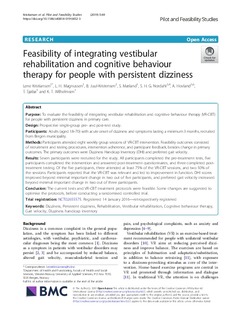| dc.contributor.author | Kristiansen, Lene | |
| dc.contributor.author | Magnussen, Liv Heide | |
| dc.contributor.author | Juul-Kristensen, Birgit | |
| dc.contributor.author | Mæland, Silje | |
| dc.contributor.author | Nordahl, Stein Helge | |
| dc.contributor.author | Hovland, Anders | |
| dc.contributor.author | Sjøbø, Trond | |
| dc.contributor.author | Wilhelmsen, Kjersti Thulin | |
| dc.date.accessioned | 2019-12-20T13:11:53Z | |
| dc.date.available | 2019-12-20T13:11:53Z | |
| dc.date.created | 2019-10-03T15:32:37Z | |
| dc.date.issued | 2019 | |
| dc.identifier.citation | Kristiansen, L., Magnussen, L. H., Juul-Kristensen, B., Mæland, S., Nordahl, S. H. G., Hovland, A., . . . Wilhelmsen, K. T. (2019). Feasibility of integrating vestibular rehabilitation and cognitive behaviour therapy for people with persistent dizziness. Pilot and Feasibility Studies, 5(1). | nb_NO |
| dc.identifier.issn | 2055-5784 | |
| dc.identifier.uri | http://hdl.handle.net/11250/2634317 | |
| dc.description.abstract | Purpose
To evaluate the feasibility of integrating vestibular rehabilitation and cognitive behaviour therapy (VR-CBT) for people with persistent dizziness in primary care.
Design
Prospective single-group pre- and post-test study.
Participants
Adults (aged 18–70) with acute onset of dizziness and symptoms lasting a minimum 3 months, recruited from Bergen municipality.
Methods
Participants attended eight weekly group sessions of VR-CBT intervention. Feasibility outcomes consisted of recruitment and testing procedures, intervention adherence, and participant feedback, besides change in primary outcomes. The primary outcomes were Dizziness Handicap Inventory (DHI) and preferred gait velocity.
Results
Seven participants were recruited for the study. All participants completed the pre-treatment tests, five participants completed the intervention and answered post-treatment questionnaires, and three completed post-treatment testing. Of the five participants, three attended at least 75% of the VR-CBT sessions, and two 50% of the sessions. Participants reported that the VR-CBT was relevant and led to improvement in function. DHI scores improved beyond minimal important change in two out of five participants, and preferred gait velocity increased beyond minimal important change in two out of three participants.
Conclusion
The current tests and VR-CBT treatment protocols were feasible. Some changes are suggested to optimise the protocols, before conducting a randomised controlled trial. | nb_NO |
| dc.language.iso | eng | nb_NO |
| dc.publisher | BioMed Central | nb_NO |
| dc.rights | Navngivelse 4.0 Internasjonal | * |
| dc.rights.uri | http://creativecommons.org/licenses/by/4.0/deed.no | * |
| dc.subject | dizziness | nb_NO |
| dc.subject | persistent dizziness | nb_NO |
| dc.subject | rehabilitation | nb_NO |
| dc.subject | vestibular rehabilitation | nb_NO |
| dc.subject | cognitive behaviour therapy | nb_NO |
| dc.subject | gait velocity | nb_NO |
| dc.subject | dizziness handicap inventory | nb_NO |
| dc.title | Feasibility of integrating vestibular rehabilitation and cognitive behaviour therapy for people with persistent dizziness | nb_NO |
| dc.type | Journal article | nb_NO |
| dc.type | Peer reviewed | nb_NO |
| dc.description.version | publishedVersion | nb_NO |
| dc.rights.holder | © The Author(s) 2019 | nb_NO |
| dc.subject.nsi | VDP::Medisinske Fag: 700::Helsefag: 800::Fysioterapi: 807 | nb_NO |
| dc.source.pagenumber | 10 | nb_NO |
| dc.source.volume | 5 | nb_NO |
| dc.source.journal | BMC Pilot and Feasibility Studies | nb_NO |
| dc.source.issue | 1 | nb_NO |
| dc.identifier.doi | 10.1186/s40814-019-0452-3 | |
| dc.identifier.cristin | 1733639 | |
| cristin.unitcode | 203,11,2,0 | |
| cristin.unitname | Institutt for helse og funksjon | |
| cristin.ispublished | true | |
| cristin.fulltext | original | |
| cristin.qualitycode | 1 | |

